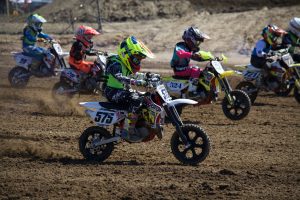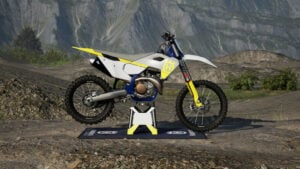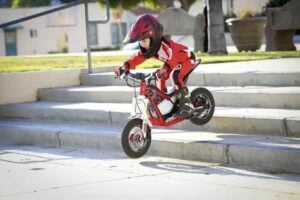We are reader-supported. When you buy through links on our site, we may earn an affiliate commission. Learn More…
Dirt Biking for Kids: The Do’s and Don’ts
Dirtbiking is not only an exhilarating sport but also a fantastic way to bond with your kids and keep them active outdoors! As a parent, it’s essential to ensure their safety and help them learn the ropes of this thrilling adventure. Are you ready to embark on this exciting journey with your little ones? Let’s jump right in!
Key Takeaways
- Gear up with protective gear and the right dirt bike for a thrilling experience!
- Learn essential skills like shifting gears, braking techniques & trail riding etiquette.
- Follow safety guidelines to ensure an enjoyable ride for all!
Essential Protective Gear for Kids Dirtbiking

Safety takes precedence when it comes to dirt biking. Ensure your kids are well-equipped with top-quality protective gear for kids before they venture onto the trails. Ill-fitting gear can lead to inferior protection, especially for children who have just started riding dirt bikes.
Dirt bike jerseys, for instance, are designed to keep young riders cool during rides, making them an excellent choice for both beginners and experienced riders. Maintaining open lines of communication is equally important when riding in groups for the safety of all participants.
Helmets and Goggles
Helmets and goggles are integral safety components in dirt biking for your child. A full-face kids helmet is highly recommended, as it safeguards the head from impacts and minimizes the risk of serious injury. Goggles, on the other hand, help keep dirt and debris out of their eyes, allowing them to focus on the thrilling ride ahead.
When selecting a helmet and goggles for your child, consider options like:
- Alpinestars Supertech M10 Carbon Helmet
- Bell MX-9 Mips
- Shoei VFX-EVO
- Fox Racing V2
These helmets offer superior performance, comfort, and protection for off-road riding, ensuring your child’s safety as they explore the world of dirt biking.
Gloves and Boots
During dirt biking adventures, gloves and boots offer necessary protection and support for kids. Gloves keep their hands safe in case of a tumble and provide a better grip on the bike handles. Youth dirt bike boots shield their feet and shins while giving them extra height to reach the ground when seated on the bike.
Some of the best gloves for dirt biking include:
- SLING MX Gloves
- iTRACK Gloves
- RIDEFIT Gloves
- AIRMATIC Glove
- Fox Racing Bomber Gloves
- Scorpion EXO Talon Gloves
- Leatt Moto 4.5 Lite Gloves
- Fly Racing Patrol XC Gloves
- Klim Mojave Pro Gloves
- REV’IT! Massif Gloves
- Troy Lee Gambit Scout Gloves
These options offer excellent protection, ensuring your child’s safety on their thrilling dirt biking journey.
Body Armor and Pads
For a safe dirt biking experience and injury prevention, body armor and pads are indispensable for kids. Neck braces, for example, keep their neck supported and protected in the event of a fall.
As the saying goes, “prevention is the best medicine,” so investing in quality body armor and pads is a must for every young rider.
Choosing the Right Dirt Bike for kids

Choosing an ideal dirt bike for your child is a key step towards guaranteeing their safety and enjoyment on the trails. Factors such as:
- Size
- Suspension
- Starter system
- Transmission
play a significant role in providing an optimal dirt biking experience for your child.
A lightweight bike with lower power is recommended for kids learning to dirt bike, as it allows them to gradually build their confidence and skills. Additionally, a good suspension system can provide excellent coverage and servicing, ensuring a smooth and comfortable ride for your little one.
Once your child becomes more confident and eager to enter the world of motocross, you can consider upgrading to a more powerful dirt bike.
Size and Suspension
Choosing the right size dirt bike for your child is essential for their safety and comfort. Here are some recommendations:
- For younger kids, a small wheel bike is recommended.
- An adjustable suspension can accommodate their growing height.
- For kids aged 4 to 7, a four-stroke 50cc engine is the best choice, offering a perfect balance of power and control.
Adjusting the suspension is necessary to make sure your child’s dirt bike is suited to their height, heightening their riding enjoyment. As your child grows, you can adjust the suspension to ensure they continue to ride comfortably and confidently.
Starter System and Transmission
Modern kids’ dirt bikes feature push-button electric start engines, simplifying the process of commencing their exhilarating ride. Safety kill switches provide added protection, ensuring your child’s safety while they learn to navigate their new dirt bike.
A four-stroke engine is the ideal choice for kids learning to dirt bike, as it offers easier throttle control and smoother acceleration than a two-stroke engine. Auto clutches in small dirt bikes allow kids to focus on learning how to ride and control their bike without worrying about changing gears. As they master the basics, they can transition to a manual transmission bike.
Adjustable speed limiters provide extra control by letting you determine the top speed for your child’s dirt bike.
Learning to Ride: Techniques and Tips for kids

With your child now equipped and ready, it’s time to impart the vital skills of dirt biking. Starting the bike, shifting gears, and braking techniques are all critical components of a safe and enjoyable dirt biking experience for your child.
To shift gears on a dirt bike, follow these steps:
- Place your foot under the shifter.
- Push the shifter up half a click for neutral.
- Push the shifter up another click for each successive gear—second, third, fourth, and fifth.
- Lower gears are great for tackling steep hills or when traveling at slow speeds.
- Higher gears can help you maintain your speed over longer distances.
- Using the clutch is essential for shifting gears smoothly and efficiently.
Starting Your Dirt Bike

Two methods exist for starting a dirt bike: the electric start and kickstart. The electric start method involves pressing the start button on the handlebar, making it quick and easy for kids to begin their adventure.
The kickstart method requires pressing down on the kickstarter lever with your foot. No matter which method is used, taking safety precautions like wearing proper protective gear and positioning the bike in a safe, open area is necessary when starting a dirt bike.
Shifting Gears
Instructing kids on smoothly and efficiently shifting gears is key to a safe and enjoyable dirt biking experience. The basic process involves pressing on the shift pedal, with the dirt bike shifting gears based on the motion of the pedal.
It’s important to ensure that the dirt bike is running at a steady speed and that the throttle is not being opened or closed too quickly when shifting gears. Also, make sure that the clutch is engaged before shifting gears to prevent stalling or overheating the dirt bike.
Braking Techniques
Effective and safe braking is an essential skill for kids learning to ride dirt bike. Dirt bikes have two types of brakes: front wheel brake and rear wheel brake. The rear wheel brake provides a smoother stop and is crucial for controlling the bike effectively.
Teaching kids to vary their braking technique according to the terrain is important, as bumpy terrain often requires more gentle braking, while smoother terrain needs more braking power. Sandy or muddy conditions can be challenging to brake in, so it’s essential for kids to adjust their technique accordingly.
Finding the Perfect track for your kids

Now that your child has the skills and gear needed for dirt biking, it’s time to find the perfect track for them to practice and have fun. From motocross clubs and ride parks to scenic trails, there are a variety of exciting dirt biking locations to choose from.
Some of the best dirt biking locations for kids include:
- Chappie-Shasta Off-Highway Vehicle Area
- Mt. Pinos East OHV Trails
- Baldy Mesa OHV Staging Area
- Clay Pit SVRA
- Ballinger Canyon OHV Day Use Riding Area
- Topanga Canyon Loop
- Carnegie State Vehicular Recreation Area
These locations offer a thrilling experience for kids of all skill levels, allowing them to explore the world of dirt biking in a safe and controlled environment.
Motocross Clubs and Ride Parks
For kids learning to dirt bike, numerous benefits can be gained from joining a motocross club or visiting a ride park. These facilities offer experienced coaches, a safe and controlled environment, and junior ride days designed specifically for younger riders.
Some of the best motocross clubs for kids include:
- Motocross Track Guide
- OSTC’s Kids Motocross Track
- Club MX – Chesterfield, SC
- Cycle Ranch – Floresville, TX
- Baja Acres – Millington, MI
These clubs offer coaching and junior ride days, providing an excellent opportunity for kids to practice their dirt biking skills and gain confidence on the track.
Scenic Dirt Bike Trails
Should your child be drawn to the natural beauty of the outdoors, scenic dirt bike trails such as:
- Black Hills National Forest in South Dakota
- Moab in Utah
- Taylor Park in Colorado
- Imperial Sand Dunes in California
- Meeker County OHV Park in Minnesota
are worth considering. These trails offer stunning scenery and are suitable for kids to enjoy dirt biking while soaking in the breathtaking views.
Each of these trails has something unique to offer, from the majestic Black Hills National Forest to
Dirt Biking with Kids

Initiating your child into dirt biking presents an exhilarating adventure for both of you. There are several important considerations to keep in mind, including age requirements, protective gear, and the use of training wheels.
There’s no such thing as ‘too early’ when it comes to teaching your kids to ride dirt bikes, as there’s no minimum age for this activity. However, it’s essential to ensure that your child is equipped with the proper protective gear and is following safety guidelines while they learn the basics of dirt biking.
Age Requirements and Recommendations
Dirt biking does not have a specific age requirement, allowing children as young as three years old to start riding small electric dirt bikes. However, it’s highly recommended that children under 13 years old ride off-road motorcycles under the direct supervision of someone 18 years or older.
This ensures that your child has a safe and enjoyable experience while they learn the thrilling sport of dirt biking.
Protective Gear for Kids
Remember, the necessary protective gear for kids dirt biking comprises:
- Helmet
- Boots
- Goggles
- Chest protector
- Knee and elbow pads
- Gloves
- Jersey with pants
Each gear item serves a critical purpose in ensuring your child’s safety on the trails, so investing in high-quality equipment is crucial.
It’s important to make sure that the gear fits properly and is comfortable for your child to
Training Wheels
Training wheels serve as a beneficial tool for children to grasp the basics of dirt biking before transitioning to two wheels. They provide extra stability and support, allowing kids to focus on learning other aspects of dirt biking.
As your child becomes more confident and skilled, you can remove the training wheels and transition them to a regular dirt bike.
Off-Roading Etiquette and Safety

Being a responsible dirt biking parent entails educating your child on off-roading etiquette and safety guidelines. Ensuring a safe and enjoyable dirt biking experience includes following trail riding etiquette and adhering to safety precautions.
When dirt biking, it’s essential to respect both other riders and the environment. This includes staying on designated trails, adhering to posted speed limits, and leaving no trace. The Motorcycle Safety Foundation (MSF) offers a one-day Dirt Bike School, which provides a fun way to learn the basics of dirt biking from a professional instructor.
Trail Riding Etiquette
Teaching kids proper trail riding etiquette is essential for a respectful and enjoyable experience for all riders, including new riders. Joining a motocross club or visiting a ride park can provide access to beginner and junior rider coaching, as well as special junior ride days that cater specifically to younger riders.
By avoiding damaging trails and leaving no trace, riders can demonstrate their courtesy to other riders and appreciation for the environment. Additionally, riders should always wear appropriate protective gear, ride within their skill level, and follow the rules of the trail to ensure a safe and enjoyable experience.
Safety Guidelines
Parents and children should always wear the appropriate protective gear and follow the rules of the trail while dirt biking. Staying on designated trails and maintaining a safe speed also helps ensure a safe and enjoyable experience for everyone involved.
By adhering to these guidelines, you can create a fun and memorable dirt biking adventure for your family.
Summary
Dirt biking is a thrilling sport that offers an excellent opportunity for bonding, adventure, and skill-building for both kids and parents. By ensuring proper safety measures, selecting the right gear and dirt bike, teaching essential techniques, and finding the perfect track, you can create unforgettable memories with your child while exploring the exciting world of dirt biking. Now gear up, hit the trails, and ride into the horizon!
Frequently Asked Questions
What is dirt bike riding called?
Motocross, often called “MX,” is a thrilling form of off-road motorcycle racing held on enclosed off-road circuits. It’s an adrenaline-pumping sport that involves high speeds on rough, natural-terrain tracks with man-made jumps, berms, and obstacles. Most tracks have open practice days and race days!
Is Dirt biking a good hobby?
Dirt biking is an incredibly popular and exciting hobby that allows you to explore the outdoors with friends and develop skills along the way – what’s not to love? It’s a great way to get out of your comfort zone and have some fun!
How hard is dirt biking?
Dirt biking is relatively easy to learn, but it takes time and skill to master. Safety must also be a priority, as proper technique is essential.
What are the essential protective gear items for kids dirt biking?
Essential protective gear for dirt biking includes a helmet, boots, goggles, chest protector, knee and elbow pads, gloves, jersey, and pants – providing vital protection so kids can enjoy the sport safely!
How can I choose the right dirt bike size and suspension for my child?
Choose the right size bike for your child’s age, then adjust the suspension to their height as they grow!






Be the first to comment